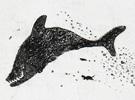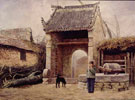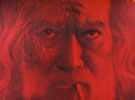Q: Why do you choose white paper?
5A:White is indeed a symbol, which stands for purity, foreverness and nobleness in the West world, where white is the right color for wedding dresses. In China, white stands for the west in direction, White Tiger in sky, silver or autumn, and so on. White is the key tone for memorial rituals. It is not only a symbol of cleanness and foreverness but also a symbol of “filial piety”.
However, white is relatively simpler than visual symbols. In the past, I applied the image of Chairman Mao, books, some traditional Chinese art symbols such as peony flowers, fruits of guava and the others to my paintings or art installations. When I have engaged in the practice of multi-layered cubic paper-cutting, I give up those prevailing symbols. What I really want is an absolute return to art itself, taking away the cover and label of a production, even its subject, letting itself moving forward into its own inside, which means let the art piece speak so as to raise or radiate the ideas to its audiences. Of course, the colors of paper are very rich and all look very nice. In the future, I am sure I will use papers of various colors for certain practices. The white color is just a choice of mine for this phase.
Q: What do you think makes letter paper and white paper different?
6A:From the view of material property, white paper and letter paper, used or printed, or graphic paper, are artificial materials, and they are symbols of culture in feature. Compared with letter paper, white paper is a symbol of culture more implicit. In the eyes of a writer or a modern, white paper is just a material, which is called “material for consuming”. A letter paper is an explicit symbol of culture, for example, a newspaper, a drawing, a photo or a book is loaded with detailed and specific images and texts. The clear designation of these signs becomes a cut-in point for an artist, or “the painting eye”. So, since the finished products have been an art, there has been a method of altering the finished products. This method is naturally tied up with the Western researches in symbolism and linguistics. All the pieces produced by altering, transforming or aggregating those books, newspapers or other finished products mainly come out in such a manner. It is also one most prevailing method in the modern art. My two works “ Dao·Utensils” and “Red Spiders” done from 1992 to 1995 were produced by the method of aggregating and altering books and finished products.
Q: What kind of paper do you think looks nice? What kind may stimulate you to alter it?
7A:I think all kinds of paper look beautiful: paper made of timber mixture, cortex, stalk, cotton, fiber, or it is recycled; refined or coarse; thin or thick paper. As long as they are employed properly, there will be no bad production.
Q: If possible, in what aspects will you alter paper?
8A:In the past, the majority of artists, of course including me, usually felt worried by the crashes in art, considering all the art methods had been used up by the previous Chinese and Western artists. But now, I think it isn’t true. With the development of science and technology, new materials will come out more and more. The constant innovations of electronic digitals will also bring out more possible chances for us to explore and go beyond the traditional technology of material applications and new visions.
As for paper, there are rich resources contributed by human traditional art over several thousand years and fruits achieved by the contemporary artists, plus the modern technical methods and the exclusive life experiences of artists themselves. All these could probably be transformed or developed to brand new methods in art, for instance, I have done certain experiments such as revolving, adding or reducing, drifting, etc. based on the layer-splitting method. Afterwards, I may be going to do certain experiments and developments on colors, images, engraved arts, cylinders and so on.
Q: What do you want the audiences will experience from the papers applied in your works?
9A:People often say that a good work can offer one an appreciation of beauty, a mental pleasure and meditation. From my own experience as an artist, I think a good work, instead, brings me certain sharp physiological reaction, just like an electroshock. In 2007, I remember I escorted Professor Lv Shengzhong as his assistant to the U.K. for his exhibition arrangement. There was a British embroidery artist who was to co-exhibit with Professor Lv also there at the same time for his exhibition arrangement. During the ten-day-long arrangement period, the exhibition planner even intendedly came and told that the artist was installing into the wall 7 screws of which the tops are cross-shaped, and on each top was studded a diamond. He set an old rectangle table in his exhibit room and placed two dirty linens over the wall corners. Because I speak no English, so we couldn’t talk, and thus I didn’t pay much attention to his doing. On the opening day, as there was the opening ceremony holding outside, I went into his exhibiting room and doubted why he hadn’t opened his room, watching that the table and the two linen pieces full of dusts from the wall were still there. I first had a look of that table, on its surface there were some remains of dopes scattered and kind of a trace left by a dope barrel bottom. When I had my second look carefully, I found all the marks were made by “spiral figuration”; then I intensely looked at the two dusty linens with certain parts already musty. When I opened one piece, I was shocked in the head and squatted down there for several minutes, hardly to stand up, since the linens were lined by embroidering. My heart was filled up with regrets for a long time, nothing else but for my silly head! I have studied Chinese folk crafts for decades, and, as it is well-known, “spiral figuration” and “embroidery” are both Chinese inherent handcrafts; moreover, my postgraduate research project is on “the Traditional Skills of Chinese Traditional Embroidery”. His work has drawn me into a deep consideration quite long and quit a lot. He first offers his audiences a new art viewpoint, showing his audiences and other artists that the attributes for art creativity are very close to us, existing in our life, our daily works, and sometimes so close as clung to the skins of everyone. It tells that even the ancient skills which have been developed to their supreme levels by our forefathers over thousands of years are still bearing chances to become modern arts as well. This master is creating a spatio-temporal course in transforming materials that impresses me very much. Fairly admire him! I favor the “wisdom-type” or “witty” arts. It is also what I am trying my best to run after. Paper related to every modern being is just like his arm. Paper is one most familiar material to everyone: reading a book, playing cards, rolling tissues, folding a mail, sorting files, packing books, counting bills, plastering a poster, providing a leaflet, and so on are our quotidian behaviors and experiences. So, the methods and cut-in points for my current works are mainly originated from these experiences besides the application of engraving. What I expect is that the audiences would excitedly praise: “The man is very smart!” when they recognize my capability of sublimating a common subsistent experience to a kind of art. This is what I want the audiences would experience from my works.
(Translated by Jiang Wenhui)




